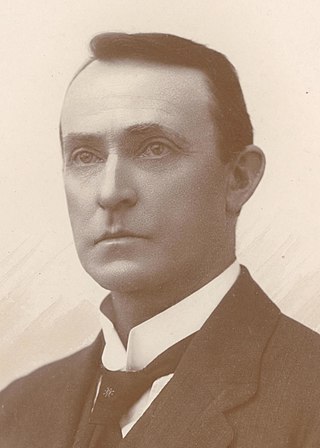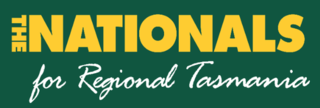
Sir Walter Henry Lee KCMG was an Australian politician and member of the Tasmanian House of Assembly. He was Premier of Tasmania on three occasions: from 15 April 1916 to 12 August 1922; from 14 August 1923 to 25 October 1923; and from 15 March 1934 to 22 June 1934.

Sir John Cameron McPhee, KCMG was an Australian politician and member of the Tasmanian House of Assembly. He was Premier of Tasmania from 15 June 1928 to 15 March 1934.

The 1919 Tasmanian state election was held on 31 May 1919 in the Australian state of Tasmania to elect 30 members of the Tasmanian House of Assembly. The election used the Hare-Clark proportional representation system — six members were elected from each of five electorates.

The 1922 Tasmanian state election was held on 10 June 1922 in the Australian state of Tasmania to elect 30 members of the Tasmanian House of Assembly. The election used the Hare-Clark proportional representation system — six members were elected from each of five electorates.
The 1925 Tasmanian state election was held on Wednesday, 3 June 1925 in the Australian state of Tasmania to elect 30 members of the Tasmanian House of Assembly. The election used the Hare-Clark proportional representation system — six members were elected from each of five electorates.

The 1928 Tasmanian state election was held on Wednesday, 30 May 1928 in the Australian state of Tasmania to elect 30 members of the Tasmanian House of Assembly. The election used the Hare-Clark proportional representation system — six members were elected from each of five electorates.

The 1931 Tasmanian state election was held on 9 May 1931 in the Australian state of Tasmania to elect 30 members of the Tasmanian House of Assembly. The election used the Hare-Clark proportional representation system — six members were elected from each of five electorates. For the first time, voting was compulsory, resulting in a high voter turnout.

The 1934 Tasmanian state election was held on 9 June 1934 in the Australian state of Tasmania to elect 30 members of the Tasmanian House of Assembly. The election used the Hare-Clark proportional representation system — six members were elected from each of five electorates.

The 1937 Tasmanian state election was held on 20 February 1937 in the Australian state of Tasmania to elect 30 members of the Tasmanian House of Assembly. The election used the Hare-Clark proportional representation system — six members were elected from each of five electorates.

The 1941 Tasmanian state election was held on 13 December 1941 in the Australian state of Tasmania to elect 30 members of the Tasmanian House of Assembly. The election used the Hare-Clark proportional representation system — six members were elected from each of five electorates.

The 1946 Tasmanian state election was held on 23 November 1946 in the Australian state of Tasmania to elect 30 members of the Tasmanian House of Assembly. The election used the Hare-Clark proportional representation system — six members were elected from each of five electorates.

David John O'Keefe was an Australian politician and journalist. He was a member of the Australian Labor Party (ALP) and served in both houses of federal parliament, as a Senator for Tasmania and holding the House of Representatives (1922–1925). He subsequently entered state parliament, serving as Speaker of the Tasmanian House of Assembly (1934–1942). Prior to entering politics he had been the editor of the Zeehan and Dundas Herald on Tasmania's west coast.

Alfred Charles Seabrook was an Australian politician. He was a Nationalist member of the Australian House of Representatives for Franklin from 1922 to 1928 and a United Australia Party member of the Tasmanian House of Assembly for Franklin from 1931 to 1934.
This is a list of members of the Tasmanian House of Assembly between the 25 March 1916 election and the 31 May 1919 election. At the 1916 election, no party won a majority, and the Liberals' Walter Lee became Premier of Tasmania. During the term, the Liberal Party converted into the new Nationalist Party, and the Labor Party split over conscription. However, most of the Parliamentary Labor Party stayed with the executive, and the two MHAs who left the Party switched to federal politics. The state of flux, however, resulted in four seats switching from Labor to Nationalist at by-elections and recounts.
This is a list of members of the Tasmanian House of Assembly between the 31 May 1919 election and the 10 June 1922 election. Nationalist MHA Walter Lee was the Premier of Tasmania throughout the term. In 1922, shortly before the election, a new Country Party emerged with several sitting Nationalist MPs joining it.
This is a list of members of the Tasmanian House of Assembly between the 10 June 1922 election and the 3 June 1925 election. The fledgling Country Party got five members elected, including two former Nationalists, but by the end of the term the party had all but merged into the Nationalist Party. A new Liberal Party emerged before the 1925 election, counting the support of three MHAs.
This is a list of members of the Tasmanian House of Assembly between the 9 May 1931 election and the 9 June 1934 election. The 1931 election produced a landslide victory for the Nationalists, in what turned out to be the non-Labor parties' last term in office until 1969.
This is a list of members of the Tasmanian House of Assembly between the 20 February 1937 election and the 13 December 1941 election. The term was elongated due to World War II.

The Tasmanian Nationals are a political party in the Australian state of Tasmania, aligned with the National Party of Australia. The party is not currently registered with the Tasmanian Electoral Commission, and is not separately registered with the Australian Electoral Commission, unlike the other state branches of the Nationals.
The Tasmanian Labor Party, officially known as the Australian Labor Party (Tasmanian Branch) and commonly referred to simply as Tasmanian Labor, is the Tasmanian branch of the Australian Labor Party. It has been one of the most successful state Labor parties in Australia in terms of electoral success.
This page is based on this
Wikipedia article Text is available under the
CC BY-SA 4.0 license; additional terms may apply.
Images, videos and audio are available under their respective licenses.








